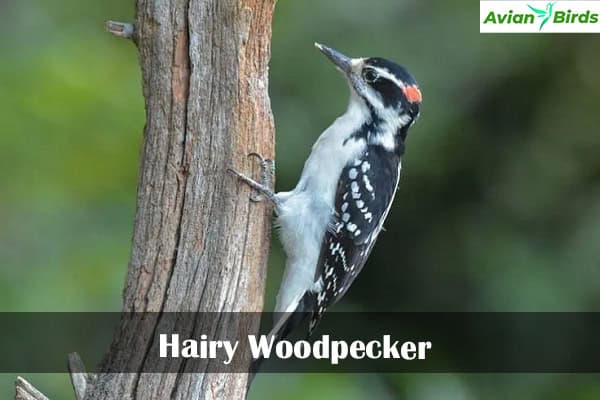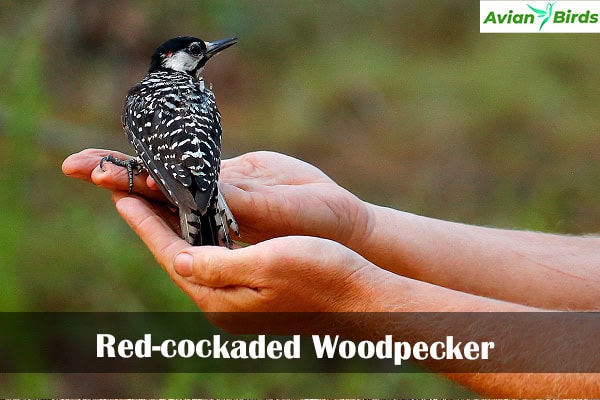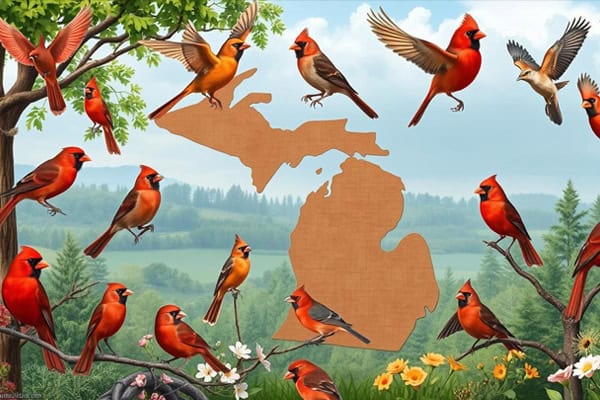8 Types of Woodpeckers in Georgia (ID Guide With Photos)
Have you ever noticed the unique sounds and colors of woodpeckers in Georgia? These birds are truly special, each one with its own traits and habits. Georgia is lucky to have such a wide range of woodpeckers, from the small Downy to the big Pileated.
But identifying them and knowing their importance can be a challenge. Join us on a fascinating trip to learn about Georgia’s woodpecker species. Dive into the secrets of these amazing birds in the Peach State.
What makes Georgia’s woodpeckers stand out in the U.S.? Let’s dig into the 8 most common types you can find in Georgia. We’ll cover how to recognize them, where they like to live, and interesting things they do. Get ready to become an expert on Georgia’s woodpeckers!
The Role of Woodpeckers in Georgia’s Ecosystems
Woodpeckers help keep Georgia’s forests and woodlands healthy by eating insects and making homes for others. Their work is crucial for the ecosystem.
- They help control populations of wood-boring insects, preventing damage to trees.
- The cavities they make are perfect for many other birds and animals to live in.
By helping other species and creating habitats, woodpeckers boost the biodiversity of Georgia’s landscapes.
| Woodpecker Species | Length | Wingspan | Weight |
|---|---|---|---|
| Downy Woodpecker | 6.75 inches | 12 inches | 0.8 ounces |
| Red-bellied Woodpecker | 9.25 inches | 16 inches | 2.5 ounces |
| Pileated Woodpecker | 16.5 inches | 29 inches | 10.5 ounces |
| Red-headed Woodpecker | 9.25 inches | 17 inches | 2.5 ounces |
| Hairy Woodpecker | 9.25 inches | 15 inches | 2.5 ounces |
| Northern Flicker | 12.5 inches | 20 inches | 4.7 ounces |
| Yellow-bellied Sapsucker | 8.5 inches | 16 inches | 1.5 ounces |
| Red-cockaded Woodpecker | 8 inches | 14.2 inches | 1.5 ounces |
Georgia’s woodpecker species have essential jobs in the environment. They help keep the ecosystem in balance by controlling insects and offering nests for many animals.
1. Downy Woodpecker
- Scientific name – Dryobates pubescens
- Lifespan – 11 years (maximum recorded)
- Size –(14 to 17 cm)
- Weight – (21 to 28 g)
- Wingspan – (25 to 30 cm)
- Status – Least concern
In Georgia, the Downy Woodpecker is the smallest of its kind. It’s only 6-7 inches long and weighs less than an ounce. You can spot it by looking for its black and white feathers. It has a white belly, a black and white back, and a little red spot on the male’s head.

The Downy Woodpecker has a unique feature. It’s beak is much shorter compared to its head size. This makes it easy for the bird to find and eat insects in tree bark. This sets it apart from the similar Hairy Woodpecker.
Habitat and Behavior
Downy Woodpeckers live in many places around Georgia. This includes woods, suburbs, and city parks. They are good at climbing and pecking to find food. With their small beaks, they look for insects in tree bark.
They often feed with other birds like chickadees and nuthatches. Being in a group helps them find more food and look out for danger.
Sounds and Calls
The most common sound of the Downy Woodpecker is a high, whinnying call. It drops in pitch. They also make a drumming sound by pecking on trees fast. This noise is for finding a mate and marking their territory. Listening for these sounds and drumming can help you find them.
| Downy Woodpecker Statistics | Value |
|---|---|
| Lifespan (average/maximum) | 2 years / 11 years |
| Size | 5.5 to 6.7 inches |
| Weight | 0.7 to 1 ounce |
| Wingspan | 9.8 to 11.8 inches |
| Population Size | Estimated 13 million stable individuals |
2. Hairy Woodpecker
- Scientific name – Dryobates villosus
- Lifespan – 15 years (maximum recorded)
- Size – (18 to 26 cm)
- Weight – (40 to 95 g)
- Wingspan – (33 to 41 cm)
- Status – Least concern
The Hairy Woodpecker and Downy Woodpecker look much the same. They are often mistaken for each other. However, a few important differences help tell them apart.

Distinguishing from Downy Woodpecker
The Hairy Woodpecker is bigger than the Downy. It has a longer, chisel-like beak that’s almost the length of its head. In comparison, the Downy Woodpecker’s beak is shorter.
Another key sign is their tail feathers. The Hairy Woodpecker has all white tail feathers on the outside. But the Downy has spots on its outer tail feathers.
- The Hairy Woodpecker is larger, with a longer, chisel-like beak that is nearly as long as its head.
- The Downy Woodpecker has a shorter beak.
- The Hairy Woodpecker has completely white outer tail feathers, while the Downy’s outer tail feathers are spotted.
Look closely at size, beak shape, and tail colors. These hints will let you pick out the Hairy Woodpecker. Knowing these details makes spotting them in Georgia’s wild and town areas easier.
3. Pileated Woodpecker
- Scientific name – Dryocopus pileatus
- Lifespan – 12 years (maximum recorded)
- Size – (40 to 49 cm)
- Weight – (250 to 350 g)
- Wingspan – (66 to 75 cm)
- Status – Least concern
The Pileated Woodpecker is the biggest woodpecker in Georgia. It is 16-19 inches long and has a wingspan up to 30 inches. You can spot them by their red crest, black and white feathers, and large, chisel-shaped bill. These birds love mature forests. They are known for their loud calls and the big, rectangular holes they make in trees.

The Largest Woodpecker in Georgia
Pileated Woodpeckers are Georgia’s biggest woodpeckers. They are 16-19 inches long with a wingspan up to 30 inches. This makes them stand out in the forest with their unique looks and size.
Habitat Preferences
Pileated Woodpeckers like living in large, untouched forests filled with dead and dying trees. These trees provide food and nesting spots for them. While not often seen in towns or cities, they might come to feeders with suet or peanuts. This happens more in winter when food is scarce.
Distinctive Calls and Drumming
These woodpeckers are loud and known for their “cuk-cuk-cuk-cuk-cuk” calls. This sound echoes through Georgia’s forests. They also drum loudly on trees. This drumming isn’t for finding insects, but to talk to each other and mark their territory. Knowing these sounds can help you find them, even if you can’t see them.
| Habitat Preferences | Population Trends | Conservation Status |
|---|---|---|
| Prefer large, undisturbed forest tracts with dead and dying trees | Population has gradually recovered since the 20th century | Least Concern (IUCN) |
| Less common in suburban and urban areas | Adapting to second-growth woods and human proximity | Protected under the Migratory Bird Treaty Act |
| May visit backyard feeders, especially in winter | Breeding bird survey data indicates stable population in Texas | Federal offense to kill or disturb nests |
4. Red-bellied Woodpecker
- Scientific name – Melanerpes carolinus
- Lifespan – 12 years (maximum recorded)
- Size – (23 to 27 cm)
- Weight – (56 to 91 g)
- Wingspan – (33 to 42 cm)
- Status – Least concern
The Red-bellied Woodpecker is a medium-sized Woodpeckers in Georgia. It has a black and white barred pattern on its back and wings. The red belly is hard to see. But, the male has a bright red crown and nape. Females have a smaller red patch on their nape. They are common in Georgia and can live in forests and suburbs.

Feeding Habits and Behavior
Red-bellied Woodpeckers eat insects, nuts, seeds, and fruits. They love backyard feeders that have suet or peanuts. These birds are very territorial. They chase other birds away from their food. They are skilled at finding food. They use their long, sticky tongues to pull out bugs from trees.
In the Eastern United States, Red-bellied Woodpeckers are known for their loud calls. You often hear them in spring and summer. They sometimes take over nests from other birds. They can face problems from European Starlings too. The oldest one found was 12 years and 3 months old in Georgia.
These woodpeckers make their nests in holes in trees. Sometimes, they hide food in trees and fence posts. They have a unique way of catching bugs. They can stick their tongue out almost 2 inches! They also fly in a way that looks like they’re playing.
Red-bellied Woodpeckers live in the East, woodland, and suburbs. Males visit backyard feeders a lot. Young ones don’t have red on their heads. They are similar in size to a Hairy Woodpecker and smaller than a Northern Flicker.
Watch for white patches near the wingtips when they fly. They have a unique flight pattern. You can see them in old oak forests or young trees. They also come to backyard feeders.
At first, their numbers were low in the north in the 1900s. But lately, they’ve been doing better and seen farther up north. The Red-bellied Woodpecker’s population is steady or growing slightly.
5. Red-headed Woodpecker
- Scientific name – Melanerpes erythrocephalus
- Lifespan – 12 years (maximum recorded)
- Size – (19 to 23 cm)
- Weight – (56 to 91 g)
- Wingspan – (35 to 43 cm)
- Status – Least concern
The Red-headed Woodpecker catches the eye with its bright crimson head, black back, and white undersides and wing spots. This mix of colors is hard to miss, making this woodpecker notable in Georgia. It’s easy to mix up males and females since they both have these striking features.

Striking Plumage and Identification
These woodpeckers are not too big and have round heads, short tails, and strong, sharp bills. They’re a bit smaller than a Northern Flicker but bigger than a Downy Woodpecker. The adult Red-headed Woodpeckers stand out with their red heads, white bellies, and black with white wings. Young ones look a little different, with brownish heads and black-spotted wings.
Habitat and Conservation Concerns
They live in open forests or parks and places with trees and open areas, like golf courses. Sadly, these birds have seen their numbers shrink because of less good habitat. Steps are being taken to help them find safe places to nest and feed in Georgia and beyond.
These woodpeckers eat insects by pecking at trees or catching them while flying. They look for bugs on the ground too and also enjoy fruits and seeds. Their voice is unique, sounding sharper and rougher compared to other woodpeckers’ calls.
Red-headed Woodpeckers have a special behavior of hiding food like bugs or seeds under wood or shingles. They might be the most territorial of North American woodpeckers, known to fight hard for their space. They can even disturb other birds’ nests or break duck eggs.
6. Northern Flicker
- Scientific name – Colaptes auratus
- Lifespan – 9 years (maximum recorded)
- Size – (28 to 31 cm)
- Weight – (110 to 160 g)
- Wingspan – (42 to 51 cm)
- Status – Least concern
The Northern Flicker is a special kind of woodpecker. It’s unique because it doesn’t just find food in tree trunks like most woodpeckers. Instead, it spends a lot of time on the ground, looking for ants and other tiny creatures with its long, chisel-like beak. This behavior, along with its brown and black feathers, makes Northern Flickers easy to spot in Georgia.

Unique Ground-Foraging Behavior
Northern Flickers move a lot, especially in the fall. The ones in the north head south for the winter. They love looking for ants on the ground, which they catch with their sharp, barbed tongues. In the late fall and winter, they also enjoy seeds, berries, and fruit that have fallen to the ground.
Plumage and Identification
Woodpecker In Georgia, you’ll find a kind of Northern Flicker called the “Yellow-shafted” flicker. It stands out with its tan body, a black bib, and a red patch on the neck. Males have a black “mustache”. When they fly, you can see bright yellow on their wings and tails. This makes them look quite different from other woodpeckers.
There are five types of Northern Flickers: Yellow-Shafted, Red-Shafted, Gilded, Guatemalan, and Cuban. The Northern Flicker is among Georgia’s year-round woodpeckers. It’s also the state’s second-largest woodpecker, after the pileated woodpecker.
Lately, Northern Flicker numbers have dropped because they’ve lost places to nest. They also have to fight for homes with other birds. Even so, their habit of ground-foraging and their unique look have kept them popular in Georgia. People love having them around.
7. Yellow-bellied Sapsucker
- Scientific name – Sphyrapicus varius
- Lifespan – 8 years (maximum recorded)
- Size – (18 to 22 cm)
- Weight – (43 to 55 g)
- Wingspan – (34 to 40 cm)
- Status – Least concern
The Yellow-bellied Sapsucker are special kind of woodpeckers in Georgia. It loves to eat tree sap. They make small holes, or “sap wells,” in trees like maples and birches. This is where they find sap to drink and insects to eat.

Sap-Feeding Specialists
These birds enjoy sap from over 1,000 tree types. They make two kinds of wells for sap: round and rectangular. Many animals, like insects and squirrels, also visit these wells.
What makes them stand out is that they are fully migratory. They move to warm areas like Georgia in the winter.
Migration and Seasonal Occurrence
Woodpeckers in Georgia, show up more in the fall and winter. Females, interestingly, travel farther south than males. This means more males are in Georgia in winter.
They like food like bird puddings, suet, jelly, and fruit. Plus, they can even feast on sunflower seeds and grape jelly.
This woodpecker’s habits and presence make it interesting in Georgia. Its unique ways of feeding on sap are a wonder to see.
8. Red-cockaded Woodpecker
- Scientific name – Dryobates borealis
- Lifespan – 16 years (maximum recorded)
- Size – in (20 to 23 cm)
- Weight – (42 to 52 g)
- Wingspan – (34 to 41 cm)
- Status – Near-threatened
The Red-cockaded Woodpecker is Georgia’s rarest woodpecker. It’s also the most endangered. This woodpecker is small, with a stunning black and white pattern. Sadly, it’s on the brink of extinction due to losing its natural home. Its survival depends on protecting the old-growth, longleaf pine areas it calls home.

Thankfully, many groups and the government are working to save it. They’re focusing on rebuilding its lost homes in Georgia. They are doing this by managing the land and planting more trees. These efforts aim to keep the Red-cockaded Woodpecker from disappearing forever.
Check Our Previous Articles:
Endangered Species and Conservation Efforts
Only 14 percent of these woodpeckers live in Georgia. Because of this, Georgia’s role in their survival is vital. The Georgia Department of Natural Resources is leading the charge. They’ve set up special plans to protect these birds on private lands.
Thanks to their work, more than 156,997 acres are now under care. This includes areas where these woodpeckers live. Such efforts are making a difference in keeping this species alive.
Cooperative Breeding and Habitat Requirements
Red-cockaded Woodpeckers have a special way of breeding. A family group with a breeding pair gets help from their relatives. This unique system helps in making sure there are new generations. It also shows how these birds depend on each other.
These woodpeckers have specific needs for their homes, too. They pick living pine trees with just the right heartwood condition. They grow their homes over a year by pecking out nesting holes. These unique trees in old forests are key to their survival. That’s why saving and managing these special forests is so important for them.
Frequently Asked Questions
Q1. What is the most common woodpeckers in Georgia?
The most common woodpecker in Georgia is the Northern Flicker (Colaptes auratus).
Q2. Are woodpeckers protected in Georgia?
Yes, woodpeckers are protected under state and federal laws in Georgia.
Q3. Is it rare to see a woodpecker?
It is not rare to see woodpeckers, especially in wooded areas and parks where they are quite active.
Q4. Which is the most common woodpecker?
The Northern Flicker (Colaptes auratus) is generally considered the most common woodpecker species in Georgia.







